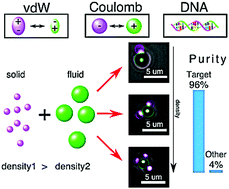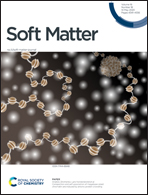Mix and match—a versatile equilibrium approach for hybrid colloidal synthesis†
Abstract
Colloidal synthesis is a powerful bottom-up approach for programmed self-assembly which holds promise for both research and industry. While diverse, each synthetic process is typically restricted to a specific chemistry. Many applications however require composite materials, whereas a chemical equilibrium can typically only match one material but not the other. Here, a scalable general approach is presented, alleviating the dependency on a specific chemical reaction, by resorting to a mechanical equilibrium; an isopycnic density-gradient-step is tailored to form clusters with prescribed composition. Valence control is demonstrated, making dimers, trimers, and tetramers with purity as high as 96%. The measured kinetics shows a scaleable throughput. The density gradient step plays a dual role of both filtering out undesired products and concentrating the target structures. The “Mix-and-Match” approach is general, and applies to a broad range of colloidal matter: diverse material compositions (plastics, glasses, and emulsions); a range of colloidal interactions (van der Waals, Coulomb, and DNA hybridization); and a spectrum of sizes (nanoscale to multiple micrometers). Finally, the strength of the method is displayed by producing a monodisperse suspension from a highly polydisperse emulsion. The ability to combine colloids into architectures of hybrid materials has applications in pharmaceuticals, cosmetics, and photonics.



 Please wait while we load your content...
Please wait while we load your content...
